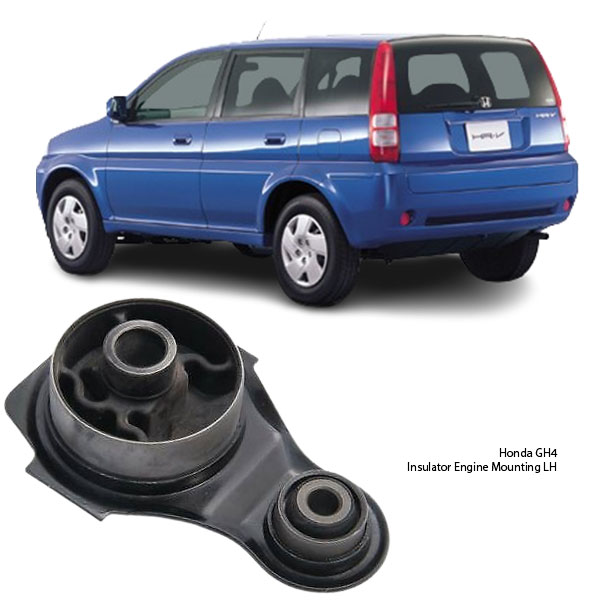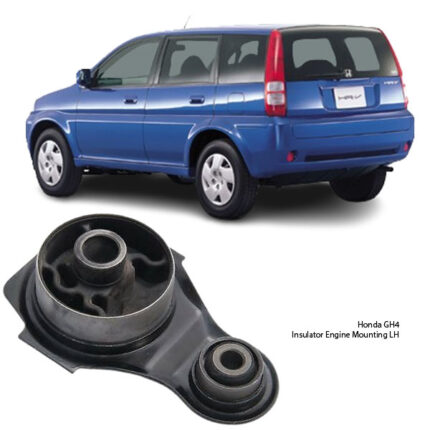-10%
Get Honda GH4 Insulator Engine Mounting LH HM-HRVMLH In Kenya
The insulator engine mounting, often referred to simply as engine mounts or motor mounts, is a crucial component of a vehicle’s powertrain system designed to secure and isolate the engine from the chassis. This assembly plays a critical role in supporting the engine’s weight, minimizing vibrations, reducing noise transmission, and ensuring smooth operation of the vehicle. Here, we will explore in detail the functions, components, types, importance, signs of issues, replacement considerations, and maintenance tips related to insulator engine mountings.
Functions and Components of Insulator Engine Mounting
- Support and Positioning: The primary function of insulator engine mountings is to support the engine and securely attach it to the vehicle’s chassis. They maintain the engine in its correct position relative to the drivetrain components and other vehicle systems.
- Vibration Isolation: Engine mounts absorb and dampen vibrations generated by the engine’s operation and road irregularities. This isolation prevents vibrations from being transmitted to the vehicle’s cabin, improving passenger comfort and reducing driver fatigue.
- Noise Reduction: By absorbing engine vibrations and minimizing their transmission to the chassis, insulator engine mountings contribute to a quieter cabin environment. This enhances the overall driving experience by reducing engine noise and harshness.
- Alignment and Stability: Engine mounts assist in maintaining proper alignment of the engine and drivetrain components, ensuring smooth power delivery and optimal performance. They help minimize drivetrain movement during acceleration, braking, and cornering.
Types of Insulator Engine Mountings
- Rubber Mounts: Traditional engine mounts often utilize rubber as the primary material for its ability to absorb vibrations and provide flexibility. Rubber mounts are cost-effective and suitable for most passenger vehicles.
- Hydraulic Mounts: Hydraulic engine mounts incorporate a fluid-filled chamber that helps further dampen vibrations and provide additional isolation. They offer enhanced performance in reducing engine noise and vibrations.
- Active/Smart Mounts: Some modern vehicles may use active or smart engine mounts that adjust stiffness and damping characteristics based on driving conditions. These mounts optimize vibration isolation and improve fuel efficiency by reducing engine load fluctuations.
Importance of Insulator Engine Mounting
Insulator engine mountings are essential for several reasons:
- Stability and Safety: They ensure the engine remains securely attached to the vehicle’s chassis, preventing excessive movement that could lead to component damage or safety hazards.
- Comfortable Ride: By isolating engine vibrations and noise, engine mounts improve passenger comfort and reduce cabin noise levels, enhancing the overall driving experience.
- Longevity of Components: Properly functioning engine mounts help extend the lifespan of drivetrain components by reducing wear and stress caused by engine vibrations and movement.
Signs of Issues with Insulator Engine Mounting
- Excessive Engine Movement: Worn or damaged engine mounts may allow excessive engine movement, especially during acceleration or deceleration. This can cause noticeable engine rocking or shifting under the hood.
- Vibration and Noise: Increased engine vibrations or noise, particularly at idle or during acceleration, can indicate worn-out engine mounts. These symptoms may be felt or heard inside the cabin.
- Visible Wear or Damage: Inspect engine mounts for visible signs of wear, such as cracks, tears, or sagging rubber. Damaged mounts may not effectively support the engine or isolate vibrations.
- Misaligned Components: Misalignment of drivetrain components or unusual engine/transmission angles can be a sign of compromised engine mounts. This can affect vehicle performance and drivability.
Replacement Considerations
- Complete Set Replacement: Depending on the vehicle’s mileage and condition, it may be advisable to replace all engine mounts simultaneously to ensure uniform performance and longevity.
- Quality Parts: Choose high-quality OEM or aftermarket engine mounts from reputable manufacturers to ensure proper fitment, durability, and vibration isolation. Consider the type of mount (rubber, hydraulic, etc.) that best suits your vehicle’s needs.
- Professional Installation: Engine mount replacement often requires lifting and supporting the engine, which can be complex and potentially hazardous without proper equipment and knowledge. It’s recommended to seek assistance from a qualified mechanic or automotive technician.
- Alignment Check: After replacing engine mounts, perform a thorough inspection and alignment check of drivetrain components to ensure proper positioning and functionality.
Maintenance Tips
- Regular Inspection: Include engine mounts in routine vehicle inspections, checking for signs of wear, movement, or abnormal noise. Address any issues promptly to prevent further damage to engine and drivetrain components.
- Fluid Leaks: Check hydraulic engine mounts for signs of fluid leaks or seepage. Replace leaking mounts to maintain proper damping and vibration isolation.
- Environmental Protection: Protect engine mounts from exposure to extreme temperatures, chemicals, and road debris. Clean and inspect mounts regularly to maintain optimal performance and longevity.
Follow us on Facebook for more parts.




